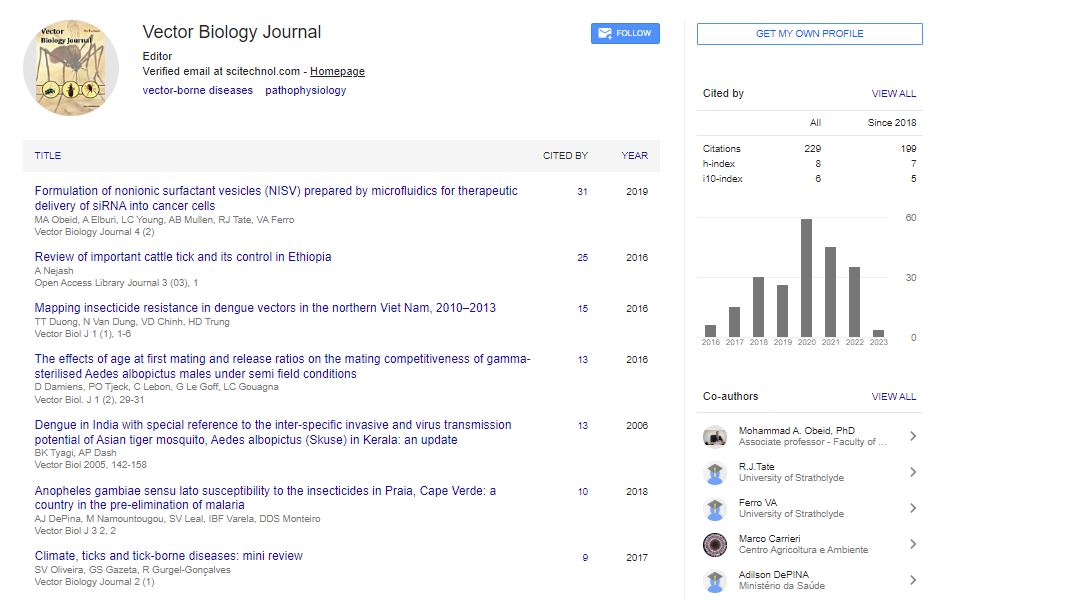Opinion Article, Vector Biol J Vol: 8 Issue: 3
Diversity, Ecology, and Seasonality: The Fundamental Aspects of the Natural World
Joycelyn S Lyons*
1 Department of Environmental Toxicology, Vector-Borne Zoonoses Laboratory, Texas Tech University, Lubbock, USA
*Corresponding Author: Joycelyn S Lyons,
Department of Environmental
Toxicology, Vector-Borne Zoonoses Laboratory, Texas Tech University, Lubbock,
USA
E-mail: Lyons56@gmail.com
Received date: 28 August, 2023, Manuscript No. VBJ-23-117760;
Editor assigned date: 30 August, 2023, PreQC No. VBJ-23-117760 (PQ);
Reviewed date: 13 September, 2023, QC No. VBJ-23-117760;
Revised date: 21 September, 2023, Manuscript No. VBJ-23-117760 (R);
Published date: 29 September, 2023, DOI: 10.4172/2473-4810.1000273
Citation: Lyons JS (2023) Diversity, Ecology, and Seasonality: The Fundamental Aspects of the Natural World. Vector Biol J 8:3.
Description
Diversity and ecology are intertwined aspects of the natural world that are influenced by seasonality. This study explores the relationships between diversity, ecology, and seasonality, emphasizing their vital roles in shaping ecosystems and species interactions. It delves into the ways in which seasonal changes impact biodiversity, community dynamics, and ecosystem functions, highlighting the importance of understanding and conserving these relationships in a rapidly changing world.
Diversity and ecology are fundamental aspects of the natural world, each deeply affected by the cyclical patterns of seasonality. Seasonality refers to the regular, annual fluctuations in environmental conditions, including temperature, precipitation, and photoperiod, which drive the life cycles and behaviors of countless species. This study aims to elucidate the intricate connections between diversity, ecology, and seasonality, focusing on how these interactions are vital for the functioning of ecosystems.
Seasonality and biodiversity
The annual rhythm of changing seasons significantly influences the distribution and diversity of life on earth. Seasonal cues trigger migrations, hibernations, and reproductive cycles in many species. For instance, in temperate regions, spring warmth prompts the flowering of plants and the arrival of migratory birds, while fall cues the shedding of leaves and the hibernation of certain animals. Seasonality helps regulate population sizes and prevents overcrowding, facilitating the coexistence of diverse species in ecosystems.
The influence of seasonality on community dynamics
Seasonality also shapes the structure and dynamics of ecological communities. It governs the availability of resources such as food, water, and shelter, which in turn affects species interactions. Predators may time their hunting to coincide with prey availability, while herbivores may adjust their diets based on the seasonal abundance of plant species. These dynamics forms a delicate balance within ecosystems, demonstrating the importance of seasonality in maintaining diversity.
Ecosystem functions and seasonality
Ecosystem functions, such as nutrient cycling, decomposition, and primary productivity, are closely tied to seasonality. Nutrient cycling is driven by the decomposition of organic matter, which varies in rate depending on temperature and moisture. Similarly, primary productivity, the synthesis of organic matter by photosynthetic organisms, follows the availability of sunlight and temperature. These functions are difficult for ecosystem health and sustainability, emphasizing the central role of seasonality in ecological processes.
Human impact on seasonality
Human activities, particularly climate change and habitat destruction, are altering the patterns of seasonality. Global warming has led to shifts in the timing of seasons, affecting the life cycles of many species. For example, earlier springs can disrupt the synchronization between predators and prey, potentially leading to imbalances in ecosystems. Additionally, deforestation and urbanization can disrupt the seasonal availability of resources and habitats for wildlife. These anthropogenic changes can have detrimental effects on biodiversity and community dynamics.
Conservation implications
Understanding the interconnectedness of diversity, ecology, and seasonality is essential for effective conservation efforts. Conservation strategies must consider the seasonal requirements of target species and the potential effects of altered seasonality. Restoration projects should aim to mimic natural seasonal patterns to support the recovery of ecosystems and biodiversity. Protecting intact habitats and mitigating climate change are key steps in preserving the delicate balance of seasonality in nature.
Conclusion
Diversity, ecology, and seasonality are interdependent components of the natural world, with seasonality playing a central role in shaping ecosystems, species interactions and ecological functions. The annual rhythms of changing seasons influence biodiversity, community dynamics, and ecosystem processes. However, human-induced disruptions to seasonality pose a significant threat to these systems. Recognizing the importance of seasonality and integrating it into conservation strategies is important for safeguarding the rich tapestry of life on our planet. Through continued analysis, education, and responsible environmental stewardship, we can better appreciate and protect the intricate dance of diversity, ecology, and seasonality that sustains the world's ecosystems.
 Spanish
Spanish  Chinese
Chinese  Russian
Russian  German
German  French
French  Japanese
Japanese  Portuguese
Portuguese  Hindi
Hindi 